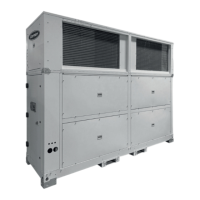18
The graphic terminal and the ground connector, both located on
the door, must be disconnected before removing it.
The grounding lug (PE), located on the panel plate,
is used to earth the frame of the unit.
Indoor module
The indoor module incorporates an auxiliary electrical cabinet
for the connection of the indoor fan and some optional elements,
such as a clogged fi lter detector, smoke detection station, etc.
The access panel is secured with M6 Allen screws.
Location of sensors controlled by "50FC" control on the unit:
8.5 "50FC" electronic control
"50FC" electronic control is basically comprised of a control
board, a graphic terminal, an user terminal (optional) and
sensors.
By default, this control is supplied with a graphic terminal,
installed on the unit’s electric cabinet, but it can also be remotely
connected:
● Up to 50 meters, it can be connected directly with telephone
wire.
● From 50 to 200 meters, it is necessary to use the TCONN
bypass cards and AWG 20/22 shielded cable with 2 twisted
pairs.
The user terminal (optional) can be installed in the electric
cabinet when the graphic terminal is remotely connected.
This board integrates two communication ports that allow
connection with a centralized technical management system
such as BOSS and BOSS mini. A BMS port for Modbus RTU
protocol and an Ethernet port for Modbus TCP/IP protocol.
A communication card (optional) can also be connected to the
control board for the following protocols: Ethernet BACnet
TM
,
MSTP BACnet
TM
and Konnex.
Note: Refer to the "50FC" control brochure to obtain more
detailed information on its operation.
Graphic terminal User terminal
Electrical
cabinet
Dual locks can function as hinges or can be used
to remove the door. Check that the locks are not
blocked. Open them with a 4 mm Allen wrench (in
an anti-clockwise direction).
Electrical components are identifi ed, and all wires are numbered.
It permits easy tracing and diagnostics.
Power cables are identifi ed with the colors: black (L1) - Brown
(L2) - grey (L3) - yellow/green (Ground).
Cable inputs from
the outdoor module
Cabinet fi xing
screws
Always ensure that the main power to the outdoor
module is turned off before working on the indoor
module.
This cabinet is foldable to allow access to the interior of the
module. It is fi xed with M4 Allen screws.
8 - ELECTRICAL CONNECTION
Outdoor T probe (duct)
S40
Return
air
S39
Outdoor T+H probe (duct)
Compr.
High press.
pressostat
S7
High
pressure
transducer
Discharge T
klixon switch
S6
Low
pressure
transducer
S8
Suction
temp.
probe
4-way
valve
(heat pump)
Outdoor fan
S1
Return
air probe
S4
Mixing
probe
Fresh
air
S5a
Ambient
air probe
S10
Air quality
probe (opt.)
Outdoor coil
Indoor coil
S3
Supply
air probe
Indoor fans
4-way
valve
(heat pump)
Outdoor fan
Outdoor coil
Indoor coil
CIRCUIT 1 CIRCUIT 2
Expansion
valve
Expansion
valve
Compr.
High press.
pressostat
S12
High
pressure
transducer
Discharge T
klixon switch
S11
Low
pressure
transducer
S9
Suction
temp.
probe
Units of 2 circuits
Note: If the unit needs the outdoor humidity probe, used with enthalpic or
thermoenthalpic free-cooling, this one (S39) will be connected in the place of
the ambient probe (S5a). In this case it is necessary to use a RS485 ambient
temperature probe connected on the Field-bus.
Power cable access routing
The power supply cables can be routed into the electrical cabinet
via the wall bushings. It is important to check that the power cable
bend radius is compatible with the connection space available
inside the electrical cabinet.

